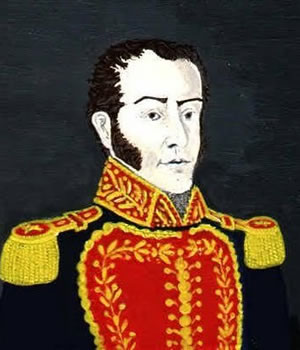Pedro Antonio Olañeta facts for kids
Pedro Antonio de Olañeta y Marquiegui (born in 1774 in Elgueta, Gipuzkoa, Spain – died April 2, 1825, in Tumusla, Potosí Department, Bolivia) was a Spanish military leader. He was a commander in the army of the Spanish Empire and fought against the South American independence movement led by Simón Bolívar.
Olañeta strongly believed in the idea of a king having absolute power. This belief caused disagreements within the Spanish army, which actually helped the rebels. Even after the main Spanish armies were defeated, he kept fighting. He was one of the last Spanish commanders to resist. Olañeta was also the last person to hold the title of Viceroy of the Río de la Plata.
Early Life and Career
Pedro Antonio Olañeta was born in a small mountain village in the Biscay region of Spain. His family was involved in trade with the colonies. Many of his uncles and cousins lived in places like Chuquisaca, Tupiza, and Cusco, building a large trading network.
In 1789, when he was about 15, Olañeta moved to South America. He traveled with his uncle, Pedro Marquegui, who was a merchant. Olañeta settled in the areas of Potosí and Salta, where he became a successful trader. By 1803, he joined the military as a Sargent Major in the cavalry. When the war for independence began, he was promoted to Brigadier General.
Leading Spanish Forces
When the May Revolution started in 1810, Olañeta chose to support the Spanish King. He fought as an officer under General José Manuel de Goyeneche against the rebels. He was promoted to colonel and later to brigadier general.
In 1821, after a new government took power in Spain, Olañeta disagreed with the Spanish Viceroy, José de la Serna e Hinojosa. Olañeta believed he was the only true defender of the King and the Church. He ordered his troops to attack other Spanish forces who supported the new government. This fighting between Spanish groups weakened their army.
The Viceroy, de La Serna, had to change his plans to fight Bolívar. He sent a large force of 5,000 experienced soldiers to fight Olañeta instead. After several battles, both Spanish armies were much smaller and weaker. This internal conflict greatly helped the independence fighters.
Final Stand and Legacy
Simón Bolívar learned about the fighting among the Spanish forces. He used this opportunity to advance his own army. Many Spanish soldiers left their side and joined the independence movement.
After the major Spanish armies were defeated in the Battle of Ayacucho, Olañeta continued to fight. He resisted Simón Bolívar's forces in what is now Bolivia. On April 2, 1825, Olañeta was badly wounded in the Battle of Tumusla. He was fighting with only a few hundred men against his own former troops, who had joined the independence side. He died the next day.
The Battle of Tumusla was the last major battle fought by regular armies in the South American wars for independence. The Spanish King, Fernando VII, had actually appointed Olañeta as the Viceroy of the Río de la Plata, but Olañeta died before he knew it. After the battle, Antonio José de Sucre called for a meeting in Upper Peru, which led to the creation of a new country, Bolivia.
See also
 In Spanish: Pedro Antonio Olañeta para niños
In Spanish: Pedro Antonio Olañeta para niños


